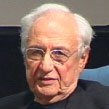 For the Atlantic Monthly's 150th anniversary issue in November, the editors "invited an eclectic group of thinkers who have had cause to consider the American idea to describe its future and the greatest challenges to it"--in 300 words or so.
For the Atlantic Monthly's 150th anniversary issue in November, the editors "invited an eclectic group of thinkers who have had cause to consider the American idea to describe its future and the greatest challenges to it"--in 300 words or so.One of those thinkers is Atlantic Yards architect Frank Gehry. (He's also #49, up from #77 last year, in Vanity Fair's New Establishment list.)
Building Dreams
In an Atlantic Monthly essay headlined Building Dreams (subscriber-only), Gehry writes as if defending his Grand Avenue plan in Los Angeles rather than his foray into an older city like Brooklyn:
 The postwar American city grew up as a development free-for-all. Suburbia became possible because of the automobile, and cities like Los Angeles just sprawled. The older American cities had concentrations of infrastructure that allowed for a New York–style density—an essential hub of urbanity that’s been missing from many of our newer cities but that now seems to be the model for the future of all American cities, including Los Angeles. The missing element, in this development free-for-all, has been architecture.
The postwar American city grew up as a development free-for-all. Suburbia became possible because of the automobile, and cities like Los Angeles just sprawled. The older American cities had concentrations of infrastructure that allowed for a New York–style density—an essential hub of urbanity that’s been missing from many of our newer cities but that now seems to be the model for the future of all American cities, including Los Angeles. The missing element, in this development free-for-all, has been architecture.Most of the buildings built would not qualify to be identified as architecture—and yet the world values architecture. People take their vacations to visit architecture of the past. The few great architectural wonders that have been built command tons of attention and generate plenty of revenue for the communities in which they reside. So the question is: Why isn’t there a movement that requires real architecture as a priority?
Uplifting effect
Gehry continues:
 Real architecture tends to have an uplifting effect on the people that experience it, and it creates identifiable icons—like the Sydney Opera House—that brand a city, even a country. Since I’m an architect, the question is perhaps self-serving; but at my age, I don’t have too much longer to benefit from the fruits of it. As I think of what’s gone on in the years I’ve been on this planet, I wonder why great architecture isn’t considered an important shaper of the American idea.
Real architecture tends to have an uplifting effect on the people that experience it, and it creates identifiable icons—like the Sydney Opera House—that brand a city, even a country. Since I’m an architect, the question is perhaps self-serving; but at my age, I don’t have too much longer to benefit from the fruits of it. As I think of what’s gone on in the years I’ve been on this planet, I wonder why great architecture isn’t considered an important shaper of the American idea. Questions raised
Gehry's essay raises a worthy issue, though arguably architecture has become part of the American idea; witness buildings like Rem Koolhaas's Central Library in Seattle. (Gehry practiced some strategic modesty in citing the Sydney Opera House; he easily could have mentioned his Disney Hall in Los Angeles.)
His question, "Why isn’t there a movement that requires real architecture as a priority?" raises further questions--among others--about the difference between government patronage in the United States and Europe/Asia, the role of top architects serving the private rather than public realm, and the still-awkward relationship between architecture and urban planning.
But, given that he has described the Miss Brooklyn tower he designed for the Atlantic Yards project as "my ego trip," and he was eager to design his first sports arena and a "neighborhood practically from scratch," Atlantic Yards may indeed serve as one of the last fruits of his "perhaps self-serving" observation.
Whether the "elegant" (according to the Brooklyn Tomorrow advertorial) Miss Brooklyn would have an uplifting effect remains in question.
The "drunken robots" party
 And the "uplifting effect" of the Stata Center of the Massachusetts Institute of Technology, now subject of a lawsuit against Gehry charging that the design led to pervasive problems, is also in question. Gehry told the New York Times that the problems were minor, that any complicated building has minor flaws, and that the client's decision to cut costs fostered the problems.
And the "uplifting effect" of the Stata Center of the Massachusetts Institute of Technology, now subject of a lawsuit against Gehry charging that the design led to pervasive problems, is also in question. Gehry told the New York Times that the problems were minor, that any complicated building has minor flaws, and that the client's decision to cut costs fostered the problems.The Times approached the lawsuit skeptically, concluding--based on, apparently, a reporter's cursory look--that "no leaking, mold or signs of structural deficiency were evident" and quoting a robotics professor who said, “It is a joy to work in this building."
In a New York Post column yesterday headlined Frank Lloyd Wrong: Cracks Finally Appear in the Fad of Gehry, Kyle Smith found a litany of complaints about the building, cited the surprising string of structural problems in Gehry buildings, and wondered, When he builds the Ground Zero arts center and the new home of the Brooklyn Nets, will he embarrass us the way he has so many others?
Fun quote: Gehry has said that the building "looks like a party of drunken robots got together to celebrate."
Comments
Post a Comment